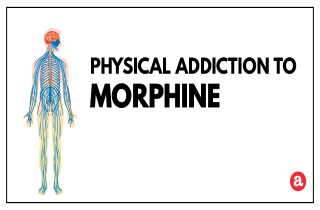Are you physically addicted to morphine? Help is available. Here, we will review signs of dependence on morphine and how to get help. Then, your questions about morphine use or treating morphine addiction are welcomed at the end.
Physical dependence on morphine
Morphine has a high risk for developing physical and psychological dependence. Chronic use and morphine tolerance can provoke these condition. Though both have the same starting point, physical and psychological dependence are two separate conditions. How?
While the dependence is a state of the body, addiction is a state of the mind, the two conditions affect totally different sections in the human brain. So you can be dependent on morphine, without being addicted to it. People being treated chronically with morphine, for example, for pain associated with terminal cancer may be dependent – if the drug is stopped, they suffer withdrawal syndrome. But, they are not compulsive users of the morphine, and they are not addicted.
How is morphine addiction different? The human brain of a morphine addict registers the effects of the morphine as a benefit, a reward, so that over time, a morphine user can begin to seek out the pleasure of getting the reward. The state in which the user engages in a compulsive behavior is called addiction. Even when faced with negative consequences, a morphine addict will lose control and take morphine again. That is how the drug addiction is psychological; the pathway to getting high is more interesting than the moments of being high themselves.
Physical dependence, on the other hand, is a state in which the human body can function normally only in the presence of certain drugs. Dependence manifests only after the drug is promptly removed, and the appearance of physiological disturbances are called withdrawal symptom.
Physical signs of addiction to morphine
When a person is dependent on morphine, withdrawal symptoms present themselves upon significant decreases in dosing or drug cessation. The physical signs of dependence on morphine can include:
- elevation of blood pressure and body temperature
- involuntary leg movements
- irritability
- liquid diarrhea
- mild depression
- vomiting
- weight loss
Symptoms start to appear within 45 to 96 hours after the last dose and continue for up to 8 to 12 days after stopping morphine.
Treating physical symptoms of addiction to morphine
Detoxification is the process during which morphine users allow the body to get rid of the drug naturally. Treating physical symptoms of addiction to morphine include managing the effects of withdrawal. The first step is always admitting the presence of the problem and asking for help. After that comes the detoxification.
Methadone, buprenorphine, and/or naltrexone are the most commonly used drugs for morphine and opiate addiction. These medications act in the same brain areas as morphine but can offer relief from cravings and can minimze withdrawal symptoms. Detox from morphine should be next be followed by treatment with a behavioral therapy and psychotherapy for people who want to stay off morphine and suspect addiction.
Physically addicted to morphine questions
After reading, do you still have some questions about morphine addiction? Feel free to ask us anything about physical addiction to morphine, and we will do our best in providing you with a correct, personal, and prompt answer.









Related Posts